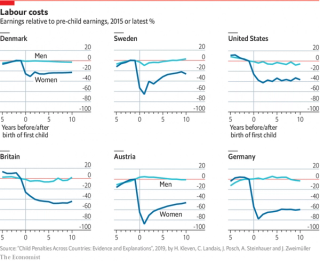
A Series of Charts Shows Mothers Take an Income Hit All Over the World
Unsurprisingly, parenthood barely affects men’s earnings.

A new analysis of six countries shows that even in the more-egalitarian West, the motherhood wage penalty is real and vast: Women’s earnings fall steeply after having a child, and never fully recover; men’s earnings remain largely unimpaired post-parenthood.
The motherhood pay gap was especially wide in Austria, reports The Economist, where men appear to receive a wage bump after having a child, and women’s earnings fall by 51%; and in Germany, where women earn 61% less 10 years after having a child, than they were earning before parenthood.

Image courtesy of The Economist
The drop in women’s post-baby wages was least evident in Denmark, where mothers’ earnings decrease by 21%, and in Sweden (27%). Sweden is also notable for a slight drop in fathers’ earnings upon parenthood; the researchers attribute this to Sweden’s parental leave policy, which mandates up to one year of post-baby parental leave as long as the father takes three months of it (the three months are forfeit if he does not).
The study included the earnings (zero) of women who leave the workforce entirely upon having children.
While the academics behind the original study note there was no data-based evidence to explain the larger wage gaps between mothers and fathers, they call out gender norms that hold mothers responsible for the majority of childcare work; the wage gap is “largely because mothers choose to work fewer hours, or in lower-paid but more child-friendly jobs, or not at all when their children are very young,” The Economist article concludes.
But let’s be clear: It’s not a choice if you are the only parent who is able to take leave immediately after having a baby. In countries like India, with its six months of maternity leave but no commensurate mandate for paternity leave, women have no choice but to sacrifice earnings in order to care for children. This sets them on the path for lower lifetime earnings, making them more likely to be financially dependent on a partner, and their work and income more disposable should the needs of home increase — creating a vicious cycle of low earnings and financial dependency.
As The Economist noted, the World Economic Forum estimates that at the current rate of progress, it will take the world 202 years to achieve gender equality in the workforce. Some countries are starting to wake up to the fact that they don’t have that kind of time. In Japan, Prime Minister Shinzo Abe has launched “womenomics,” aimed at propping up the country’s slowing economy by facilitating women’s participation in the workforce. While 67% of women there already hold jobs, traditional gender roles enforce a steep divide in women’s earning power, pigeonholing them in small-fry work roles so they can continue to do five times (or more) the amount of carework than men in a given week.
India, where only 27% of women (and likely less) are part of the formal labor force, faces a similar problem: Strong societal messages that convey to women their best efforts for success lie within the home, and societal expectations that they excel there even if they hold down a full-time job, create a leaking pipeline of female workers, post-motherhood, and an ever-growing financial gap between the genders. When the choice is to hold down a full-time job and simultaneously do 10 times the amount of carework in a week as a man, or devote oneself to carework full-time — again, it’s often not a choice. The government is hinting at moves similar to Japan, announcing last year the first national survey to track the value of women’s unpaid housework. This quantification is the first step in crafting much-needed policies to equalize the load — and thus, equalize women’s career and earnings potential.
Liesl Goecker is The Swaddle's managing editor.
Related


Women May Be Less Likely to Ask For More Money if Their Boss Is a Man
